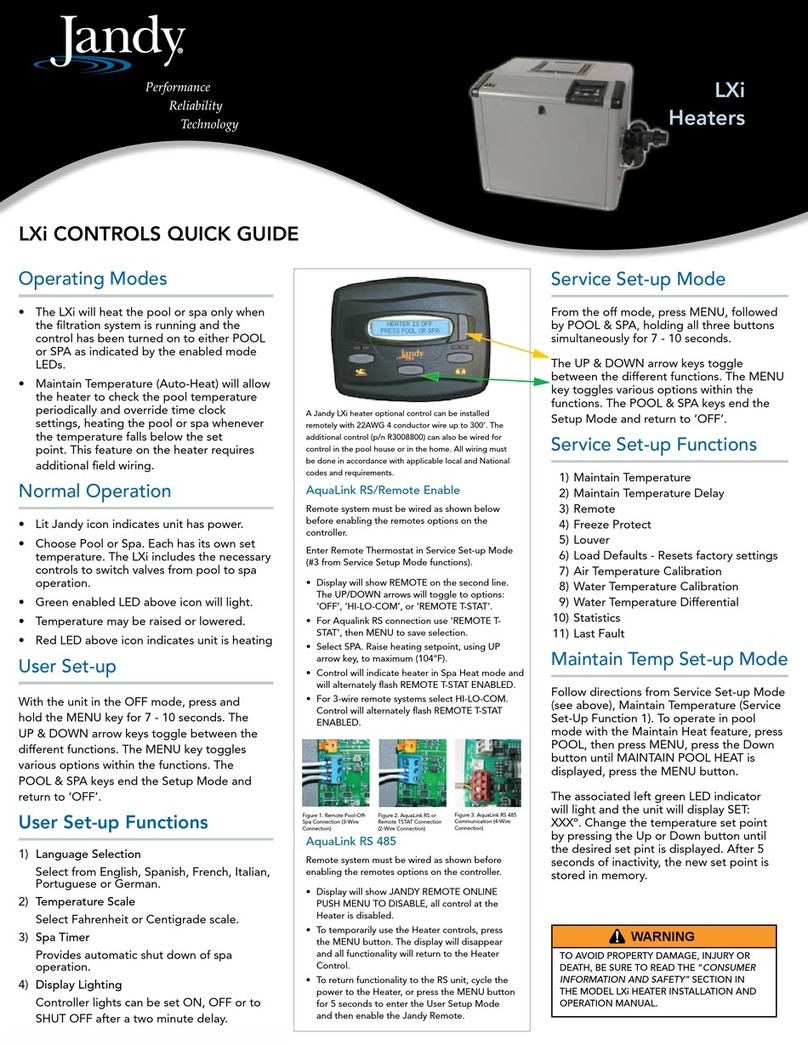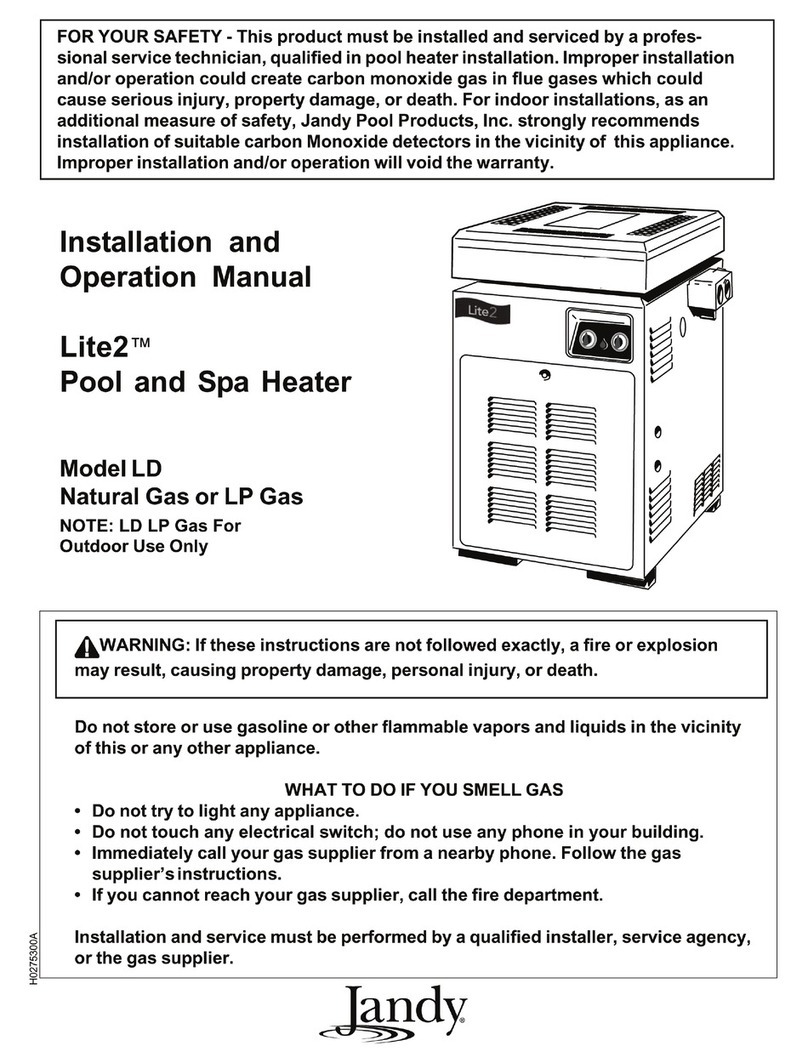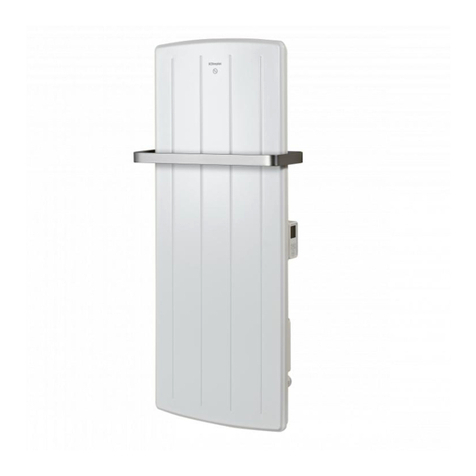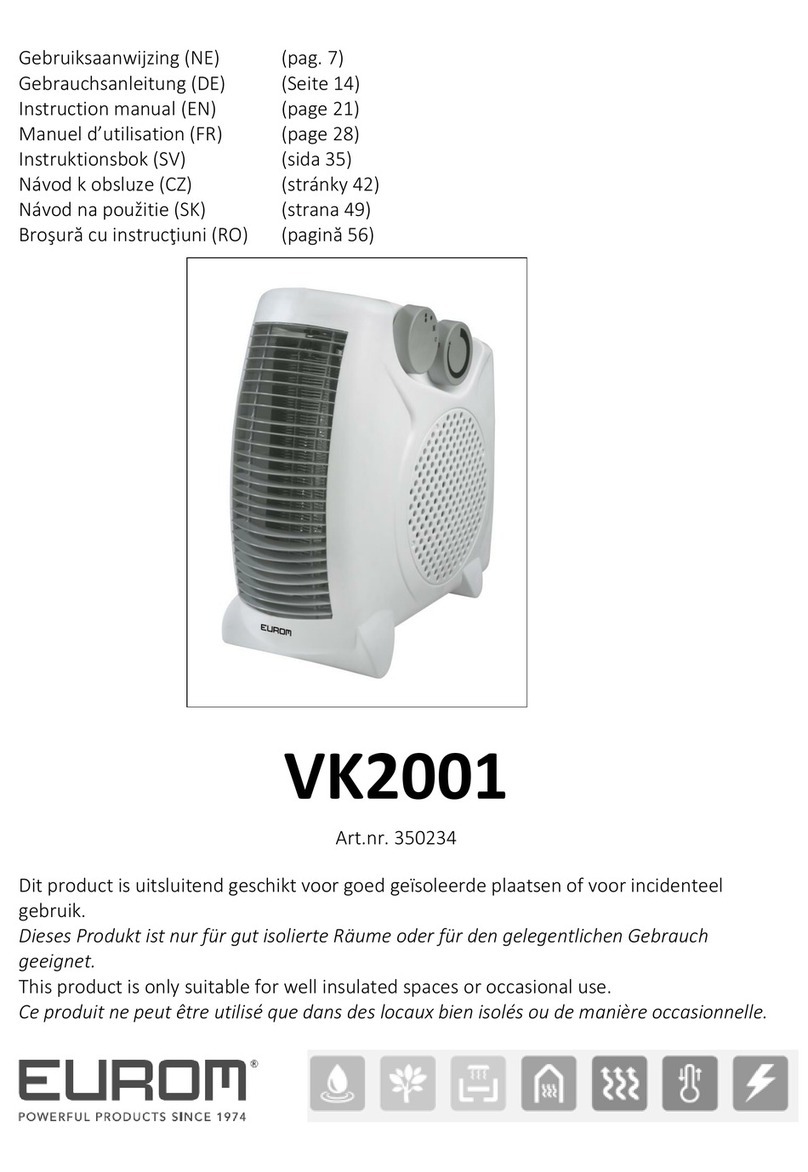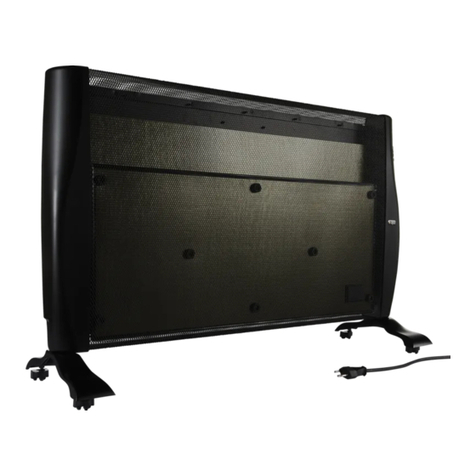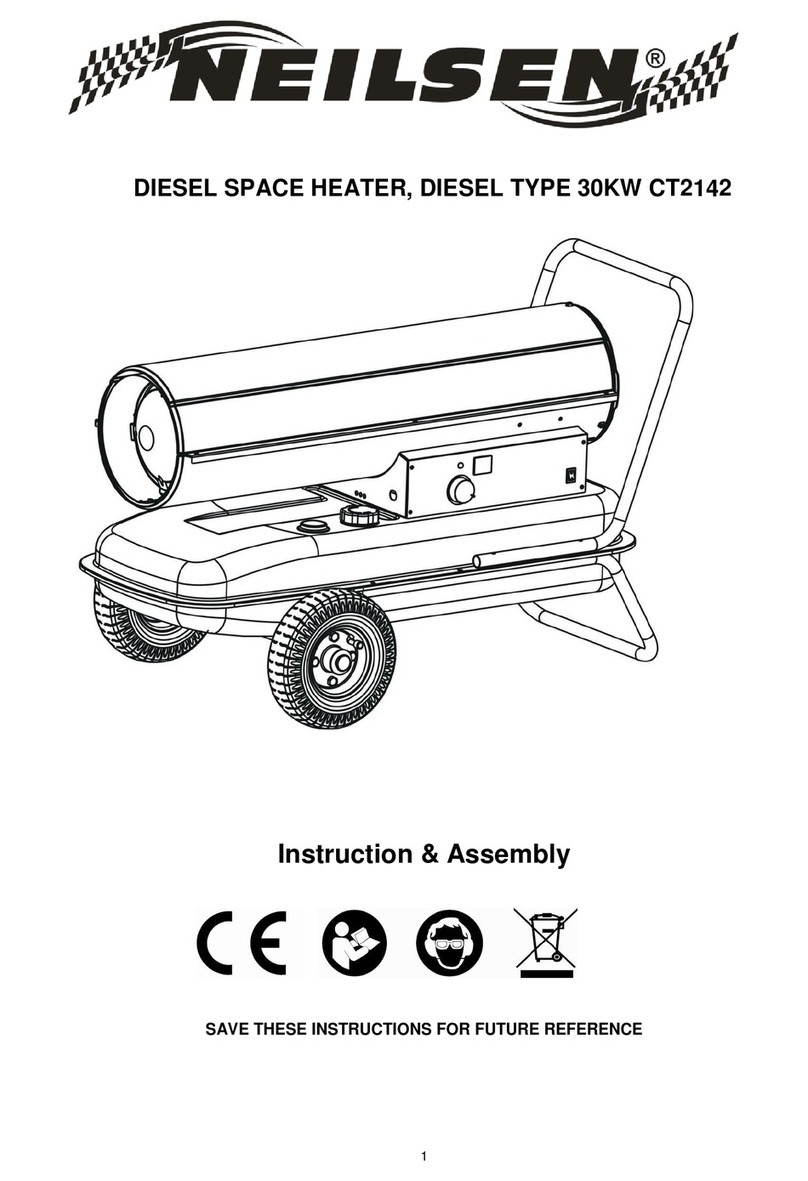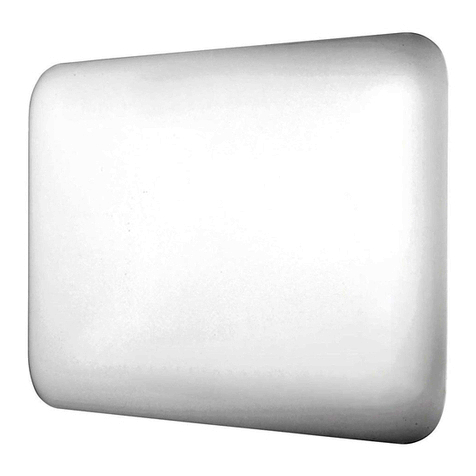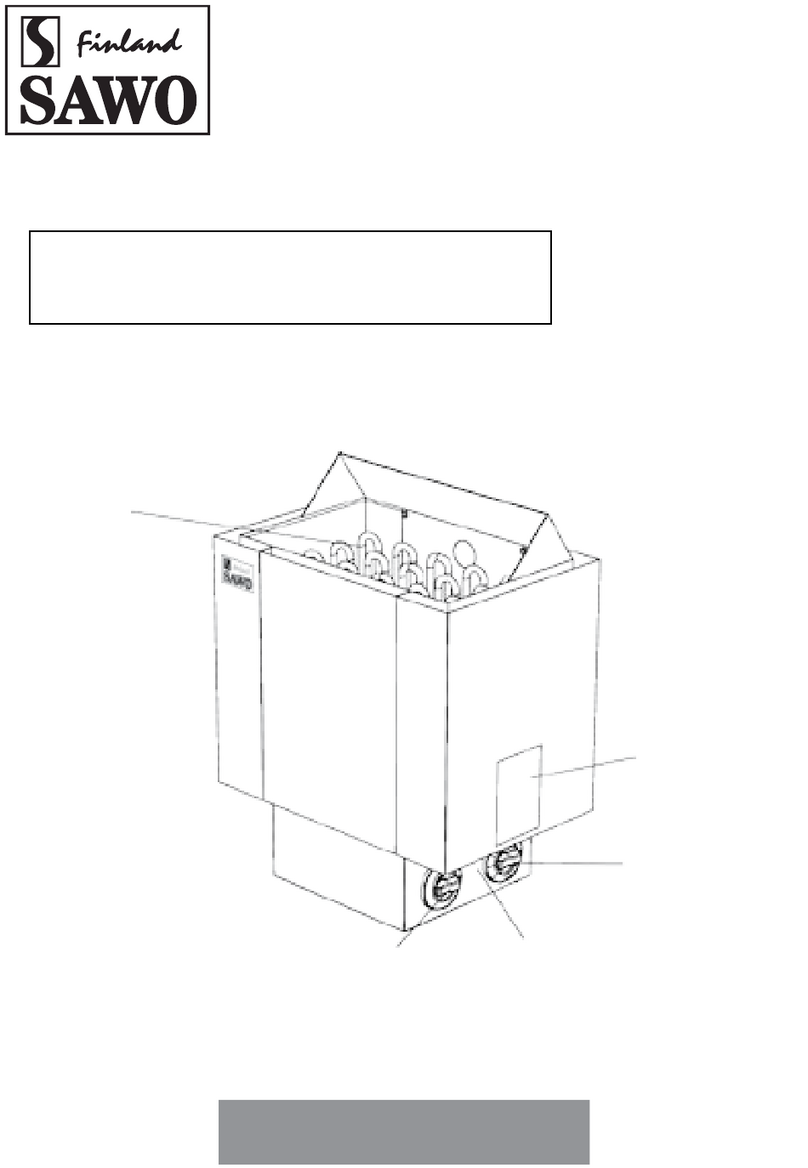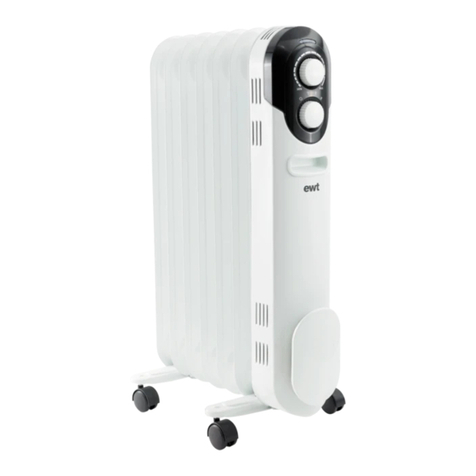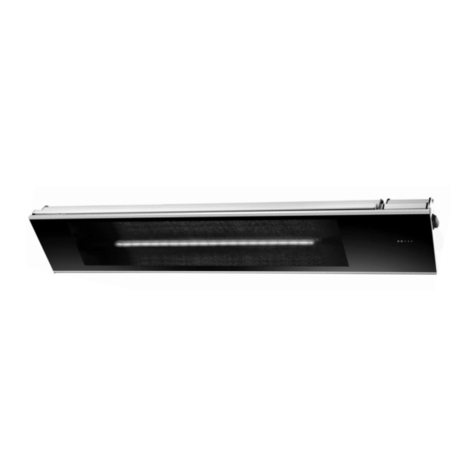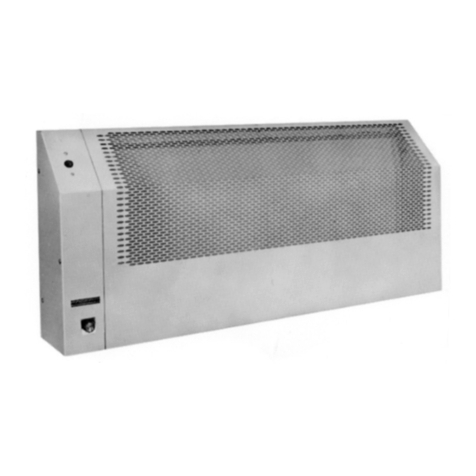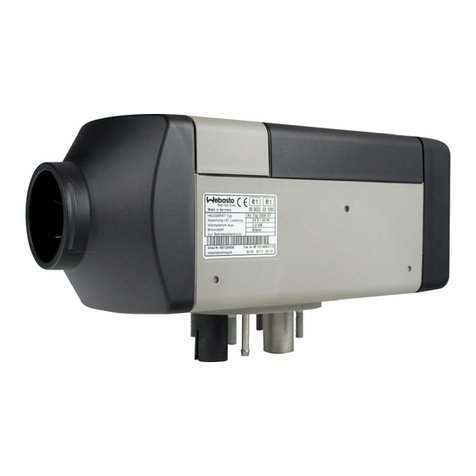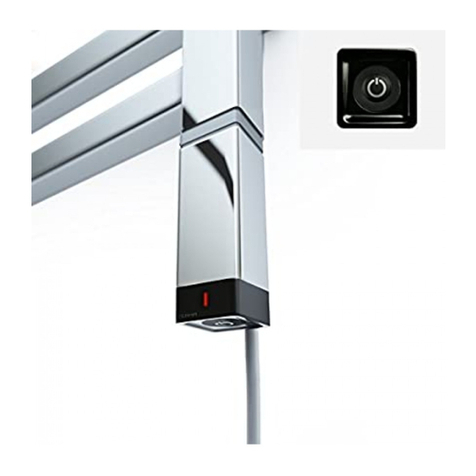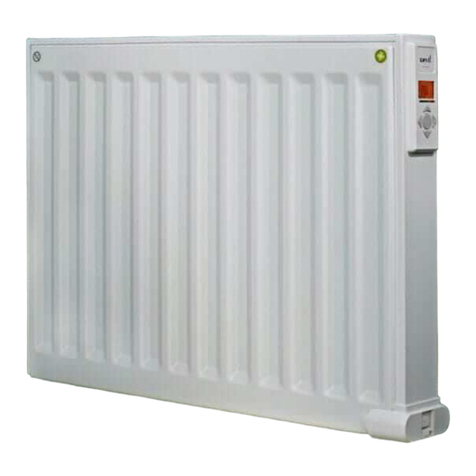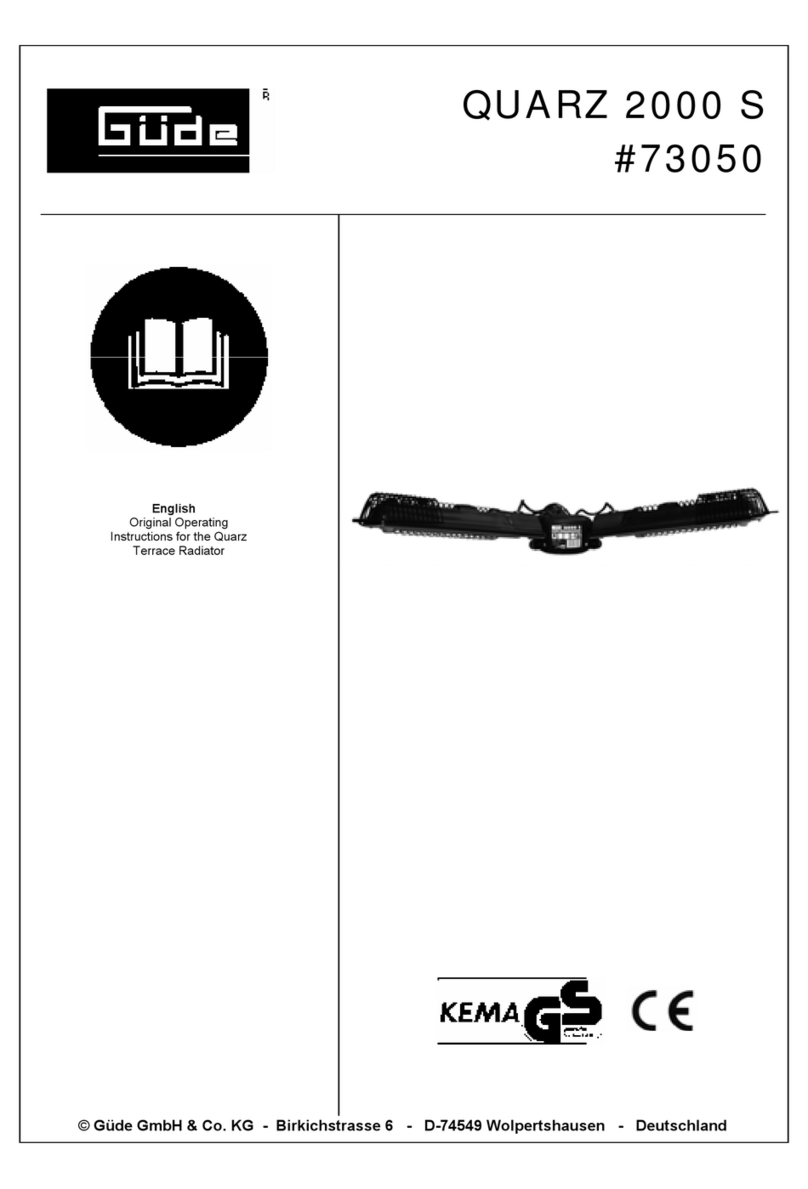Jandy DP3000 User manual

H0223500A
FOR YOUR SAFETY - This product must be installed and serviced by authorized
personnel, qualified in pool/spa heater installation. Improper installation and/or operation
can create carbon monoxide gas and flue gases which can cause serious injury, property
damage, or death. Improper installation and/or operation will void the warranty.
Installation and Operating Data
WARNING
If these instructions are not followed exactly, a fire or explosion may result,
causing property damage, personal injury, or death.
Do not store or use gasoline or other flammable vapors and liquids in the
vicinity of this or any other appliance.
WHAT TO DO IF YOU SMELL FUEL
• Do not try to light any appliance.
• Do not touch any electrical switch; do not use any phone in your building.
• Immediately call your fuel supplier from a neighbor’s phone. Follow the fuel
supplier’s instructions.
• If you cannot reach your fuel supplier, call the fire department.
Installation and service must be performed by a qualified installer, service
agency or the fuel supplier.
Installation and
Operation Manual
XL-3™
Oil-Fired Pool
and Spa Heater
Model DP3000
No.2 Fuel Oil Only
POOL PRODUCTS

TABLE OF CONTENTS
SECTION 1.
General Information
1.1 Introduction ................................................... 1
1.2 Shipping Damage .......................................... 1
1.3 Consumer Information and Safety .................. 1
1.3.1 Spa/Hot Tub Safety Rules ............................. 1
1.3.2 Swimming Pool Energy Saving Tips .............. 2
1.4 Warranty ....................................................... 2
1.5 Codes and Standards .................................... 2
1.6 Technical Assistance .................................... 2
1.7 Materials Installer Must Provide ..................... 2
1.7.1 Materials For All Applications ........................ 2
1.7.2 Materials Fro Special Applications ................ 3
1.8 Specifications ................................................ 3
1.8.1 General Specifications .................................. 3
1.8.2 Dimensions ................................................... 3
SECTION 2.
Installation Instructions
2.1 Introduction ................................................... 4
2.2 Field Assembly ............................................. 4
2.3 Location Requirements .................................. 4
2.3.1 Introduction ................................................... 4
2.3.2 Clearances .................................................... 5
2.3.3 Flooring ......................................................... 5
2.3.4 Outdoor Installation ....................................... 6
2.3.5 Indoor and Outdoor Shelter Installation .......... 6
2.3.5.1 Installing a Barometric Draft Control .............. 6
SECTION 3.
Venting
3.1 Combustion Air Supply .................................. 7
3.2 Exhaust Venting ............................................ 8
3.2.1 Outdoor Installations ..................................... 8
3.2.2 Indoor and Outdoor Shelter Installation .......... 8
SECTION 4.
Fuel Connection
4.1 Fuel Supply and Piping ................................. 9
SECTION 5.
Water Connection
5.1 Water Piping ............................................... 10
5.2 Check Valve Installation .............................. 10
5.3 Automatic Flow Control ............................... 11
5.4 Reversible Water Connections ..................... 11
5.5 Connections At Heater ................................ 12
5.6 Pressure Relief Valve .................................. 13
5.7 Auxiliary Components, Chlorinator, Ozone
Generators, and Sanitizing Chemicals ... 13
SECTION 6.
Electrical
6.1 GeneralInformation ..................................... 14
6.2 Main Power ................................................. 14
6.3 Bonding ....................................................... 14
6.4 Auxiliary Time Clock Wiring ........................ 14
SECTION 7.
Operating Instructions
7.1 Normal Operation ........................................ 15
7.2 Start Up ...................................................... 16
7.3 Temperature Control .................................... 17
7.4 Lighting The Heater ..................................... 17
7.5 Setting The Time Clock ............................... 18
7.7 Temperature Rise ........................................ 19
SECTION 8.
Maintenance
8.1 Water Chemistry ......................................... 19
8.2 Seasonal Care ............................................. 20
8.2.1 Spring and Fall Operation ............................ 20
8.2.2 Winterizing .................................................. 20
8.2.3 Spring Start-up ............................................ 21
8.3 Inspection and Service ................................ 21
8.3.1 Owner Inspection and Maintenance ............. 21
8.3.2 Professional Inspection and Maintenance .... 22
SECTION 9.
Trouble Shooting
9.1 Home Owner Trouble Shooting .................... 23
9.1.1 Oil Burner Does Not Fire ............................. 23
9.1.2 Heater Does Not Maintain The Desired Water
Temperature ........................................ 23
9.1.3 Burner Operates, But There Is Smoke Or ........
Pulsating Combustion .......................... 23
9.1.4 Pool Water Overheating.............................. 23
9.2 Professional Trouble Shooting Guide ........... 23
9.2.1 Introduction ................................................. 23
9.2.2 Initial Checks .............................................. 23
9.2.3 Trouble Shooting ......................................... 24
9.2.3.1 Burner Will Not Start (Motor and Transformer ..
Do Not Come On) ................................ 24
9.2.3.2 Burner Tries To Start, But The Primary Control
Shuts Off (Either Motor Or Transformer Or
Both Come On) .................................... 24
9.2.3.3 Oil Burner Will Not Shut Off ......................... 25
9.2.3.4 Setting The Correct Fuel/Air Mixture ............ 25
9.2.3.5 Control And Cad Cell Trouble Shooting
Guide .................................................. 26
SECTION 10.
Replacement Parts
10.1 Ordering Information .................................... 26
10.2 Parts List .................................................... 26
10.3 Exploded View ............................................ 28
Warranty .................................................... Back Cover

Model DP Oil-Fired Heater Page 1
SECTION 1.
General Information
1.1 Introduction
This manual provides installation and operation
instructions for the Laars XL-3 oil-fired pool and spa
heater. Read these installation and operation
instructions completely before proceeding with the
installation. Consult the Jandy factory or local
factory representative with any questions regarding
this equipment.
The Laars XL-3 heater get it's electrical power
from an external 115VAC source and provides a
thermostat control system for maintaining your pool or
spa at a comfortable temperature.
The Laars XL-3 heater is specifically designed
for heating fresh water swimming pools and spas and
with proper installation and care it will provide years
of reliable service. Do not use the heater to maintain
pool or spa water temperature below 70°F. Do not
use it as a heating boiler or general service water
heater or to heat salt water. Consult your dealer for
the appropriate Jandy products for these applications.
NOTICE TO INSTALLER: Deliver all
documents that come with the heater to the pool
owner. These include the Owners Information and
Operating Manual and this Installation Manual.
NOTE: Read the Owners Information Manual
before starting this installation and before starting up
the heater the first time.
1.2 Shipping Damage
After unpacking the heater check for visible
damage from shipment mishandling. Remove the
inspection plug on the inner panel and use a mechanics
mirror to inspect the firebox for cracks or other
damage. Water Pik Technologies carefully
manufactures inspects and packages the heater
before delivering it to the freight carrier. Immediately
file any claim for damage against the freight carrier.
1.3 Consumer Information and Safety
The Laars XL-3 heater is designed and
manufactured to provide many years of safe and
reliable service when installed operated and
maintained according to the information in this manual
and the installation codes referred to in later sections.
Throughout the manual safety warnings and cautions
are identified by the " " symbol. Be sure to read and
comply with all of the warnings and cautions.
WARNING
For your safety do not store gasoline or other
flammable liquids or vapors in the vicinity of this or
any other appliance.
Use only #2 fuel oil or #2 diesel fuel. Heavier
fuels will not operate satisfactorily and their use
will void the warranty.
1.3.1 Spa/Hot Tub Safety Rules
WARNING
The following Safety Rules for Hot Tubs,
recommended by the U.S. Consumer Product Safety
Commission, should be observed when using the
spa.
WARNING
The U.S. Consumer Product Safety Commission
warns that elevated water temperature can be
hazardous. Consult heater operation and installation
instructions for water temperature guidelines before
setting temperature.
1. Spa or hot tub water temperature should never
exceed 104°F (40°C). One hundred degrees
Fahrenheit (100°F [38°C]) is considered safe for
a healthy adult. Special caution is recommended
for young children.
2. The drinking of alcoholic beverages before or
during spa or hot tub use can cause drowsiness
which could lead to unconsciousness and
subsequently result in drowning.
3. Pregnant women take note! Soaking in water
above 102°F (38.5°C) can cause fetal damage
during the first three months of pregnancy (which
could result in the birth of a brain-damaged or
deformed child). If pregnant women are going to
use a spa or hot tub they should make sure the
water temperature is below 100°F (38°C)
maximum.
4. The water temperature should always be
checked with an accurate thermometer before
entering a spa or hot tub. Temperature controls
may vary by as much as 4F° (2C°).
5. Persons with a medical history of heart disease
diabetes circulatory or blood pressure problems
should consult their physician before using a hot
tub or spa.
6. Persons taking any medication which induces
drowsiness (e.g. tranquilizers antihistamines or
anticoagulants) should not use spas or hot tubs.
7. Prolonged immersion in hot water can induce
hyperthermia.
Hyperthermia occurs when the internal body
temperature reaches a level several degrees above the
normal body temperature of 98.6°F (37°C). Symptoms
include dizziness fainting drowsiness lethargy and an
increase in the internal body temperature. The effects
of hyperthermia include:

Page 2 POOL PRODUCTS
Lack of awareness of impending hazard
Failure to perceive heat
Failure to recognize need to leave spa
Physical inability to leave spa
Fetal damage in pregnant women
Unconsciousness resulting in a danger of
drowning
1.3.2 Swimming Pool Energy Saving Tips
Water Pik Technologies offers the following
recommendations to help conserve fuel and minimize
the cost of operating your pool heater without
sacrificing comfort.
1. The American Red Cross recommends a maxi-
mum water temperature of 78°F (25°C). Use an
accurate pool thermometer. A difference of 4F°
(2°C) between 78°F and 82°F (26°C and 28°C)
will use as much as 40% more fuel.
2. Carefully monitor the water temperature of your
pool in the summertime. You can reduce heater
usage due to warmer air temperatures.
3. Set the pump time clock to start the pump no
earlier than 6:00 AM during the pool heating
season. This is the time when nightly heat loss
balances.
4. If the pool is only going to be used on weekends
reduce the heater temperature control setting by
8 or 10 degrees during the week. Reset it to the
78°F (25°C) level a day or so before you plan to
use the pool.
5. During the winter or when on vacation for longer
than a week shut down the heater by following
the shutdown instructions found on the inside of
the heater.
6. Where possible shelter the pool from prevailing
winds with well-trimmed hedges or other land-
scaping cabanas or fencing.
7. Always use a pool cover when practical. Besides
providing a valuable safety feature a pool cover
will reduce heat loss conserve chemicals and
reduce the load on filter systems.
1.4 Warranty
The Laars XL-3 heater is sold with a limited
factory warranty. Details are specified on the back
cover of this manual and the home owner's guidelines.
Make all warranty claims to an authorized Jandy
representative or directly to the factory. Claims must
include the heater serial number and model (this
information can be found on the rating plate)
installation date and name of the installer. Shipping
costs are not included in the warranty coverage.
The warranty does NOT cover damage caused
by improper assembly installation operation or field
modification. Also damage to the heat exchanger by
corrosive water is NOT covered by the warranty. See
Section 8.1 for maintaining proper pool water
chemistry.
NOTE: Keep this manual in a safe place for future
reference when inspecting or servicing the heater.
1.5 Codes and Standards
The Laars XL-3 pool and spa heater is certified
by UL (Underwriters Laboratory) as complying with
the latest standard of UL726 "Oil-Fired Boiler
Assemblies Oil-Fired Service Water Heaters and
Swimming Pool Heaters" CAN/CSA-B140.12
All Jandy heaters must be installed in accordance
with the local building and installation codes as per the
utility or authorities having jurisdiction. All local codes
take precedence over national codes.
In the absence of local codes refer to the latest
edition of the following national codes for installation:
1. In the United States "The National Fuel and Gas
Code" ANSI Z223.1. Specifically refer to Part
7 "Venting of Equipment".
2. In Canada "The Installation Codes for Gas
Burning appliances and Equipment" CAN/CGA
B149.
Any changes to the heater gas controls gas
orifices wiring draft diverter or improper installation
may void the warranty. If change is required to any of
the above consult the factory.
1.6 Technica Assistance
Consult Water Pik Technologies or your local
Jandy distributor with any questions or problems
involving the specifications installation and operation
of your Jandy equipment. An experienced technical
support staff is ready to assist you in assuring the
proper performance and application of Jandy products.
For technical support call the Water Pik Technologies
Technical Service Department at (707) 776-8200
extension 260.
1.7 Materia s Insta er Must Provide
1.7.1 aterials for All Applications
The following items are needed and are to be
supplied by the installer for all XL-3 heater
installations:
1. The correct size and length of fuel line to supply
fuel from the storage tank to the heater (see
Section 4.1 for correct fuel pipe size).

Model DP Oil-Fired Heater Page 3
2. A manually operated fuel valve to be installed in
the fuel line near the storage tank.
3. A 115V AC power supply and all wire and
conduit needed to supply electricity to the heater.
A junction box is not needed at the heater
connections are made inside of the heater jacket.
1.7.2 aterials for Special Applications
In addition to the items listed above the following
items are needed for special applications.
1. A factory authorized barometric draft control and
any vent pipe needed for indoor installations in
the USA and outdoor shelter installations in
Canada (see Section 3.2.2). Barometric draft
controls are available from any Laars distributor.
2. The appropriate size metal pipe to connect to the
inlet/outlet header of the heater. Do not connect
any type of plastic pipe directly to the heater.
3. A non combustible platform for installation on
combustible surfaces (see Section 2.3.3). Non
combustible bases are available from your Jandy
distributor.
1.8 Specifications
1.8.1 General Specifications
1. Installation Location:
Certified for use:
In the USA: Indoor and Outdoor
In Canada: Outdoor and Outdoor Shelter
2. Minimum Clearance From Combustible Material:
See Table 1 in Section 2.3.2
3. Supply Fuel Type:
Certified for use with:
#2 Fuel Oil or # 2 Diesel Fuel.
4. Burner Rating:
315 BTU/Hr
5. Fuel Consumption:
2.25 GPH (US Gallons per Hour)
4. Water Pipe/Heater Connection:
1 1/2" Threaded Iron Pipe or
1 1/4" Unthreaded Iron Pipe or
1 1/2" Copper Tubing
7. Water Flow Rate:
Maximum: 60 gpm (228 lpm)
Minimum: 30 gpm (110 lpm)
8. Working Water Pressure:
Maximum: 75 psi
9. Exhaust Vent Connection Size:
Model DP3000 9" Diameter
10. Electrical Supply:
115 Volts AC 60 Hertz 1 Phase.
11. Modification of Heater for High Altitude:
Adjustment of air shutter to obtain most efficient
combustion.
12. Shipping Weight:
315 lbs.
1.8.2 Dimensions
See Figure 1 for a diagram showing the heater's
exterior dimensions and dimensions to critical
connections on the heater.
FRONT VIEW
SIDE VIEW
Figure 1. XL-3 Model DP3000 Oil-Fired Heater.

Page 4 POOL PRODUCTS
SECTION 2.
Installation Instructions
2.1 Introduction
WARNING
Improper installation or maintenance can cause
nausea or asphyxiation from carbon monoxide in flue
gases which could result in severe injury, or death.
CAUTION
The Laars XL-3 heaters are designed to operate at all
altitudes. Adjustments to the air band and end
shutter of the burner can be made to compensate for
changes in altitude. Contact your Jandy
representative or Water Pik Technologies' Customer
Service Department for more information.
Install the Laars XL-3 heater and vent systems in
accordance with the procedures in this manual local
codes and ordinances and in accordance with the
latest edition of the appropriate national code (see
Section 1.5 "Codes and Standards").
All oil-fired products require correct installation
to assure safe operation. The requirements for pool
heaters include the following:
1. Field assembly (if required)
2. Appropriate site location (clearances) and
flooring
3. Sufficient combustion and ventilation air
4. Properly sized fuel line.
5. Proper electrical wiring
6. Adequate water flow
This manual provides the information needed to
meet these requirements. Review all application and
installation procedures completely before continuing
the installation.
2.2. Fie d Assemb y
The Laars XL-3 heater can be installed in a
variety of ways some of them requiring preparation or
assembly in the field. The XL-3 is shipped with the
inner stack packaged on top of the control panel door
in the box with the heater. The inner stack must be
assembled and installed before mounting the vent cap
or vent pipe. To assemble the inner stack remove the
tape and small envelope from the sheet metal coil.
Expand the coil until the holes on each end are aligned.
Use the two screws supplied in the small envelope to
secure the ends together. Install the inner stack 7"
(18cm) diameter on the collar of the flue collector
before attaching the vent cap (outdoor installation) as
shown in Figure 2. The Laars XL-3 heater is also
designed for "Indoor" installations in the United States
and "Outdoor Shelter" installations in Canada when
equipped with a barometric draft control and the
appropriately sized exhaust vent.
Check the Parts List (Section 10.2) of this
manual for the correct Jandy vent cap part number.
For specific installation information see Section 2.3.5
"Indoor and Outdoor Shelter Installations".
Water connections are provided on the right side
of the heater but can be changed to the left side by
reversal of the heat exchanger. It is best to handle
these preparations before the heater is installed in its
final location. See Section 5.4 "Reversible Water
Connections" of this manual for instructions.
2.3 Location Requirements
2.3.1 Introduction
CAUTION
When pool equipment is located below the pool
surface, a leak from any component can cause large
scale water loss or flooding. Water Pik Technologies
cannot be responsible for such water loss or flooding
or resulting damage.
The Laars XL-3 heater may be installed indoors
or outdoors as outlined in later sections. Location of
the heater below or above the pool deck affects
operation of its water pressure switch. See Section
5.1 water piping for more information about this.
Avoid placing the heater in locations where it can
cause damage by water or condensate leakage. If this
is not possible provide a suitable drain pan to catch
and divert any leakage. The pan must not restrict the
air flow around the heater.
All criteria given in the following sections reflect
minimum clearances as stated in the national
standards. However each installation must also be
evaluated taking into account the prevailing local
Figure 2. Inner Stack.

Model DP Oil-Fired Heater Page 5
Ta le 1. Minimum Heater Clearances From Com usti le Surfaces
Note: Clearances listed in Table 1 are
manufacturer's tested values. These are
given as minimum values. Where local
and national codes apply, and values
are different than those listed in Table 1,
use the greater value to ensure safe
operation.
conditions such as wind speed and direction proximity
and height of walls that may block ventilation and
proximity to public access areas.
2.3.2 Clearances
The heater must be placed to provide clearances
on all sides for maintenance and inspection. There
must also be minimum distances maintained from
combustible surfaces (see Table 1).
At least 24" (457mm) access must be available in
front of the heater for burner removal.
If the heater is to be installed in a garage or
similar structure all burners and burner ignition
devices must have a minimum 18" (457mm) clearance
above the floor.
This heater must be installed at least 5 feet
(1.52m) from the inside wall of a pool unless the
heater is separated from the pool by a solid fence wall
or other permanent solid barrier.
2.3.3 Flooring
The heater must be installed on a floor of
noncombustible construction or on fire-resistant slabs
or arches. Noncombustible flooring is defined as
flooring material and surface finish not capable of
being ignited and burning and with no combustible
materials against the underside. Acceptable materials
are those consisting entirely of a combination of steel
iron brick tile concrete slate glass or plaster. Do not
install the heater directly on a combustible wood or
carpet floor without placing a noncombustible platform
between the floor and the heater.
The heater can be installed on a combustible
floor if a noncombustible base assembly available
from Jandy is used. See the Parts List (Section 10) of
this manual for the appropriate base part number.
Heaters must never be insta ed direct y on
carpeting.
As an alternative to the Jandy noncombustible
base plate in the United States the National Fuel Gas
Code allows a heater to be placed on a combustible
surface when there is a platform under the heater
made of hollow masonry no less than 4 inches (102
millimeters [mm]) thick covered with sheet metal at
least 24 gauge thick and extending beyond the full
width and depth of the heater by at least 6 inches (76.2
mm) in all directions. The masonry must be laid with
ends unsealed and joints matched to provide free
circulation of air from side to side through the masonry
(see Figure 3). If the heater is installed in a carpeted
alcove the entire floor of the alcove must be covered
by a noncombustible panel.
Figure 3. Non-Com usti le Platform.
Notes:
1. Blocks must provide a solid base and be braced so they
cannot slip out of place.
2. Air openings in blocks must be arranged to provide
unrestricted openings through entire width or length of
base.
3. Sheet metal must be at least 24 ga. and e tend 6"
beyond the heater jacket on all sides.
6"
6"
HOLLOW
CONCRETE
BLOCKS
SHEET
METAL
COVER
FOEDIS
RETAEH
)RETLEHSROODTUO(ROODNI
NOITALLATSNI
NOITALLATSNIROODTUO
SEHCNISRETEMITNECSEHCNISRETEMITNEC
KNALB 651651
RAER 651651
GNIPIP 42164216
POT
YENMIHC(
)ROTCENNOC
310.33AERADEFOORNUNEPO
TNORF 42164216

Page 6 POOL PRODUCTS
2.3.4 Outdoor Installation
For outdoor configuration the XL-3 heater must
be installed with a factory authorized vent cap installed
over the inner stack. See Section 2.2 "Field Assembly"
for installation of the inner stack. See Section 10
"Parts List" for instructions on ordering a factory
authorized vent cap.
Locate the heater in an open, unroofed area.
Do not install the heater under a deck. Do not locate
the heater below or adjacent to any doors glass
openings louvers grills etc. which connect in any
way with an inhabited area of a building even though
the access might be through another structure (e.g. a
garage or utility room). In the United States there must
be a minimum of four (4) feet (1.22 m) horizontally
and four (4) feet (1.22 m) vertically between the
heater exhaust point and any door glass opening or
gravity inlet to a building. In Canada the heater must
be installed so that the exhaust point of the heater is at
least ten (10) feet (3.0 m) from any building opening
(see Figure 4).
WARNING
United States
Do not install the heater with the top of the vent
assembly within 4 feet (1.22 m) horizontally and 4
feet (1.22 m) vertically of any opening into a building.
Canada
Do not install the heater with the top of the vent
assembly within 10 feet (3.05 m) of any opening into
a building.
The top surface of the heater must be at least
three (3) feet above any forced air inlet or intake
ducts located within ten (10) feet horizontally.
If the heater is installed under an overhang there
must be a minimum clearance of 5 feet (1.5 m) above
the top of the heater and the structure should not
overhang the heater more than 12 inches (0.30 m). The
area under the overhang must be open on three sides.
This prevents combustion gases from being diverted
into living areas through doors windows or gravity
inlets.
If the heater is installed close to a structure
protect it from rain water runoff with rain gutters on
the roof or other measures. Do not locate the heater
near irrigation sprinkler systems that could spray water
on it. Water from sprinklers may cause damage to
controls and electronic components.
Avoid locations where wind deflection off nearby
structures might cause downdraft conditions. Where
downdraft conditions exist locate the heater at least 3
feet (0.91 m) from vertical surfaces (e.g. nearby
buildings and walls).
2.3.5 Indoor and Outdoor Shelter
Installations
An outdoor shelter (Canada only) is an
unoccupied enclosure which does not communicate
directly with occupied areas. All indoor installations
and outdoor shelter installations require the addition of
a factory approved barometric draft control. The
barometric draft control must be installed without
modification and in accordance with the instructions
provided by the manufacturer.
These codes standards and Water Pik
Technologies require that the heater be properly
vented as outlined in this manual. Proper ventilation of
exhaust and combustion air are essential for the safe
and efficient operation of the heater (See Section 3
"Venting").
2.3.5.1 Installing a Barometric Draft
Control
A barometric draft control must be installed
between the heater and the vent pipe with a minimum
13 inch clearance between the chimney connector and
any combustible material. Observe NFPA Standard
No. 31 and all national and local ordinances. See
Section 3 "Venting" for the proper location of the
barometric draft control when constructing the stack.
For more information on the correct barometric draft
control for your heater contact your local Jandy Pool
Products dealer.
Figure 4. Outdoor Heater Installation.

Model DP Oil-Fired Heater Page 7
SECTION 3.
Venting
3.1 Combustion Air Supp y
The heater location must provide sufficient air
supply for proper combustion and ventilation of the
surrounding area as outlined in the latest edition of
ANSI standard Z223.1 or in Canada CAN/CGA-
B149.1 or .2 and any local codes that may be
applicable.
In general these requirements specify that the
room in which a heater is installed should be provided
with two permanent air supply openings; one within 12
inches (305mm) of the ceiling the other within 12
inches (305mm) of the floor. All indoor installations
must have openings to outside air for combustion
ventilation and dilution of flue gases from inside the
building (see Figure 5 and Table 2). Water Pik
Technologies does not recommend indoor installations
that do not provide combustion air from outside the
building.
All outdoor shelter installations (Canada only)
must have uninterrupted openings to outside air for
combustion and ventilation. The installation must be in
accordance with the latest edition of CAN/CGA B149.
Water Pik Technologies does not recommend outdoor
shelter installations that depend on internal air for
combustion. Combustion air should be ducted to the
heater from outside the structure.
Outside Air Supp y: When combustion air is
supplied directly through an outside wall each opening
should have a minimum free area of one square inch
per 4 000 BTU/Hr (1.2kW) input of the total input
rating of all appliances in the enclosed area. If air is
provided through horizontal ducts each opening and
duct must provide one square inch of flow area for
each 2000 BTU/Hr (0.6 kW).
The XL-3 model DP3000 has an input rating of
315 000 BTU/Hr. The vent opening requirements for
the XL-3 heater are summarized in Table 2. Note that
the areas specified are net free areas and should be
increased when the openings are covered by screens
louvers grills or other protective covers (see Figure 5
and Table 2 notes).
Note: In Canada follow Canadian Standard
CAN/CGA-B149.1 .2 or local codes.
Figure 5. Com ustion Air, Indoor Installation.
Ta le 2. Air Openings to Outside.
Required Net Free Open Area*
for Combustion Air Openings
Direct from outside Duct from outside
Model in2(cm2)in
2(cm2)
DP3000 79 (510) 158 (1020)
*Area indicated is for one of two o enings; one at floor level
and one at the ceiling, so the total net free area would be double
the figures indicated. For s ecial conditions, refer to NFPA54
ANSI Z223.1. In Canada refer to the National Standard
CAN1-B149.1 or .2 which differs from this table.
Note: If using screens and/or metal louvers, compensate by adding
50% additional area to each opening
If using wood louvers each opening must be at least four times
the area indicated in the table above.
Exhaust Fans or Vents: Any equipment which
exhausts air from the room where the heater is
installed can deplete the combustion air supply or
reverse the natural draft action of the venting system.
This could cause flue products to accumulate in the
room. Additional air must be supplied to compensate
for such exhaust.
The information in Table 2 is not applicable in
installations where exhaust fans or blowers of any type
are used. Such installations must be designed by
qualified engineers.

Page 8 POOL PRODUCTS
The heater must be completely isolated and
protected from any source of corrosive chemical
fumes such as those emitted by trichlorethylene
perchloroethylene chlorine etc.
WARNING
Do not store any chemicals, cleaners, or other
corrosive material near combustion air openings or in
the room. Avoid locating dryer vents in the vicinity of
combustion air openings. Failure to prevent corrosive
materials from mixing with combustion air can result
in reduced heater life and unsafe heater operation.
3.2 Exhaust Venting
The XL-3 heater has a vent collar fitting as part
of the heater's top panel. The diameter of the vent
collar and thus the minimum diameter of the vent pipe
to be used is 9 inches. The on y correct procedure
for vent pipe sizing is to do so in accordance with
these instructions and the app icab e insta ation
code as stated in the fo owing "Danger"
warning.
DANGER
Vent pipe diameter must be as required by the
National fuel Gas Code Z223.1 or the Canadian
Installation Codes for Gas Appliances CAN 1-B149.1
& 2. Undersize pipe can result in inadequate venting
and oversize pipe can result in vent condensation. In
either case the result can be release of combustion
products to the indoors. This can cause serious
injury or death by carbon monoxide poisoning or
asphyxiation.
3.2.1 Outdoor Installations
For outdoor installations a factory authorized
vent cap with a 9 inch diameter must be installed and
secured to the vent collar fitting on the top panel of the
heater. Exhaust venting considerations will determine
the placement of the heater (See Section 2.3.4). If the
heater cannot be placed so as to meet the
requirements stated in Section 2.3.4 a vent pipe may
be added to the heater to move the exhaust vent
opening to a position that complies with the
requirements. In all cases vent pipes must be of the
same diameter as the exhaust outlet of the heater.
Approved vent pipes may be obtained through your
Jandy distributor.
3.2.2 Indoor and Outdoor Shelter
Installations
All indoor installations and outdoor shelter
installations require the addition of a factory approved
barometric draft control. The barometric draft control
must be installed without modification.
All vent installations must be made in accordance
with all local state or provincial codes and with:
1. Chapter 7 " Venting of Equipment" of the
national Fuel Gas Code ANSI 223.1 latest
edition or the applicable provisions of the local
building codes.
2. In Canada CAN/CGA B149.1 or .2.
Avoid terminating heater vents near air
conditioning or air supply fans. The fans can pick up
exhaust flue products from the heater and return them
inside the building creating a possible health hazard.
Do not locate the vent terminal where flue
products could strike against building materials and
cause degradation.
Vent opening should be well away from trees or
other obstructions that would prevent free air flow to
and from vent terminal. Do not terminate the vent
under decks stairways or carports.
Be sure to support all venting so that connections
will not separate and so that the weight of the vent
pipe does not rest on the heater vent collar. All
connections should be made with rustproof sheet metal
screws. Do not weld or fasten the vent pipe to the
heater vent collar. The heater top must be easily
removable for normal heater service and inspection.
The vent collar outlet is to be connected to an
unobstructed barometric draft control and vent pipe of
the same diameter terminating in a chimney or directly
outside the building. The vent must terminate at least
two (2) feet (0.6 m) above the highest point of the roof
or other object that is within ten (10) feet (3.0 m) of
the vent termination. The vent pipe must have a listed
vent cap which allows a full equivalent opening for flue
products (see Figure 5).
Install all venting as specified in the latest edition
of the National Fuel Gas Code ANSI Z 223.1 or in
Canada CAN/CGA-B149.1 and B149.2
Run the vent pipe as directly as possible with
minimum turns. Never use a vent smaller than 9"
(23cm). On lateral runs maintain a minimum pitch of
1/4" (.6cm) per linear foot. If a chimney is used the
total equivalent straight length of flue piping between
the heater and the chimney should not exceed 75% of
the vertical height of the chimney above the flue pipe
connection. The chimney should be at least 9" (23cm)
diameter. Maintain adequate clearances between the
vent pipe and combustible materials. Check local
codes and the vent manufacturers instructions for
proper clearances. The 7" (18cm) dia. inner stack
must be in place.
Any change in the amount of draft in the
combustion chamber can affect the flame
characteristics. An approved barometric draft control
must be used on all indoor installations to maintain a
clean and consistent flame (see Figure 6). When the
system is properly adjusted the pressure in the stack
below the draft control will be approximately minus
.03" W.C. If this draft pressure cannot be achieved
the chimney is too short or too small. Take corrective
action.

Model DP Oil-Fired Heater Page 9
Avoid locating the chimney termination in a
location susceptible to downdraft conditions or near
ventilation inlets to the building.
When venting multiple appliances through one
common duct each appliance must have it's own
barometric draft control (see Figure 6). Refer to ANSI
Z223.1 or in Canada to CAN/CGA B149.1 or 2 for
more information on multiple venting.
SECTION 4.
Fuel Connections
4.1 Fue Supp y and Piping
Review the following general instructions before
continuing the installation.
WARNING
The Laars XL-3 pool and spa heater was designed for
use only with #2 fuel oil or #2 diesel. DO NOT
ATTEMPT TO CONVERT THIS HEATER FOR USE
WITH ANY OTHER TYPE OF FUEL.
1. Fuel piping installation must be in accordance
with all local or national codes that apply. Local
ordinances take priority over national codes.
Figure 6. Venting, Indoor Installation.
2. Check the fuel supply to be sure that only #2 fuel
oil or #2 diesel fuel will be used to supply the
heater. Laars XL-3 heaters as shipped from the
factory are certified to operate at sea level but
the burner air shutter can be adjusted to operate
the heater efficiently at high altitudes
3. Use the figures in Table 3 to size the fuel inlet
piping from the fuel storage tank to the heater.
Check all local codes for compliance before
installing the heater.
4. Always install the fuel filter provided with the
heater in the fuel inlet pipe just outside the heater
jacket.
5. Install an approved shutoff valve at the fuel
storage tank for service and safety.
6. Before operating the heater test the complete
gas supply system and all connections for leaks.
All XL-3 heaters are equipped with two-stage
fuel units. This enables the heater to be connected
with a either a single pipe or a two pipe fuel supply
system. In locations where the fuel storage tank is
above the level of the heater inlet a single pipe system
may be used. Water Pik Technologies recommends a
two-pipe system with a supply line and a return line
between the heater and the tank (see Figure 7) for all

Page 10 POOL PRODUCTS
other installations. When using a two-pipe system
install the bypass plug in the fuel unit. The plug is
shipped in the small plastic bag attached to the oil
burner. The location for the plug is shown on the decal
on the end of the fuel unit. Remove the large hex-head
fitting and insert the plug using an Allen wrench.
Check the instructions attached to the fuel pump for
proper fuel connections. Compression fittings are not
recommended.
See Table 3 for correct fuel line sizes. NEVER
USE TUBING SMALLER THAN 3/8" (1cm).
Water Pik Technologies provides an oil filter with
the XL-3 heater. Install this filter using the fittings
provided for convenient servicing of the oil burner and
filter (see Figure 8). Post a notice near the heater
stating filter service frequency.
Provide a code approved high quality shutoff
valve at the oil supply tank.
SECTION 5.
ater Connections
5.1 Water Piping
Figure 9 illustrates typical piping for pool
equipment.
The heater must be protected from back-
siphoning of water which can result in dry starts. If
there is any chance of back-siphoning provide a check
valve between the pool and the filter pump inlet.
Arrangement of pool system components other
than as illustrated in these diagrams can affect the
operation of the heaters water pressure switch.
Location of the heater above or below the pool water
surface can also affect operation of the switch. In
general the pressure switch can be adjusted to
accommodate this effect if the heater water
connections are no more than six feet below the pool
water surface and no more than 15 feet above it. See
instructions for pressure switch adjustment (Section
7.6) for more information about this.
Note that when pool equipment is located below
the pool surface a leak can result in large scale water
loss or flooding. Water Pik Technologies cannot be
responsible for such water loss or flooding or the
damage caused by either occurrence.
5.2 Check Va ve Insta ation
For normal installations do not install a shutoff
valve or any kind of variable restriction in the water
piping between the heater outlet and the pool/spa.
Install a check valve if there is any chance of
back-siphoning when the pump stops. Do not install any
other valve in the piping between the heater outlet and
the pool unless it is being used as a diverter valve. For
special installations such as water connections below
the water level of the pool or for other questions
contact the Water Pik Technologies Technical Service
department at (707) 776-8200 ext. 260.
Figure 7. One-Pipe and Two-Pipe Systems.
ONE-PIPE SYSTEM
Figure 8. Oil Filter Installation.
TWO-PIPE SYSTEM
Ta le 3. Fuel Line Sizes.
Lift From
Bottom of Total Tu ing Total Tu ing
Storage Tank Length Allowed Length Allowed
to Fuel Pump Using 3/8" dia. Using 1/2" dia.
on Heater Pipe Pipe
0 ft. (0.0m) 68 ft. (20.7m) 100 ft. (30.5m)
2 ft. (0.6m) 63 ft. (1 9.2m) 100 ft. (30.5m)
4 ft. (1.2m) 58 ft. (17.7m) 100 ft. (30.5m)
6 ft. (1.8m) 53 ft. (16.2 m) 100 ft. (30.5m)
8 ft. (2.4m) 48 ft. (14.6m) 100 ft. (30.5m)
10 ft. (3.0m) 42 ft. (12.8m) 100 ft. (30.5m)
12 ft. (3.7m) 37 ft. (11.3m) 100 ft. (30.5m)
14 ft. (4.3m) 32 ft. ( 9.8m) 100 ft. (30.5m)
16 ft. (4.9m) 27 ft. ( 8.3m) 100 ft. (30.5m)
18 ft. (5.5m) 22 ft. ( 6.7m) 88 ft. (26.8m)

Model DP Oil-Fired Heater Page 11
5.3 Automatic F ow Contro Va ve
The inlet/outlet header of the XL-3 heater comes
equipped with an automatic flow control valve. The
automatic flow control valve maintains the proper flow
through the heater at rates up to approximately 60
Gallons Per Minute (GPM) (227 liters per minute
[LPM]). If the filter system flow rate is higher than
approximately 60 GPM (227 LPM) install a manual
bypass valve (see Figure 9) then perform a
temperature rise test (see Section 7.7) and adjust the
flow using the bypass valve until the proper
temperature rise is obtained.
5.4 Reversib e Water Connections
The XL-3 heater is shipped with water
connections on the right side but changing the
connections to the left side could simplify the
installation or improve access for service and
maintenance. Make the change before locating and
connecting the heater. This procedure for reversing
the connections involves removing the heat exchanger
and reinstalling it turned 180° from it's original position.
Some of the heater wiring and control components
must be relocated so this procedure must be done only
by a qualified service technician.
Heat exchanger reversals are generally done
before the installation of power and water to the
heater. If you need to reverse the heat exchanger on a
previously installed heater be sure that all electrical
power the gas supply and water supply have been
turned off before starting the procedure.
Follow these step-by-step instructions and
Figures 10 and 11 to reverse the heat exchanger:
Figure 9. Water Piping.
Manual by ass is used
only when filtration rate
normally exceeds
60 gallons er minute
Thermometer For
Testing Temperature
Rise
1. Remove the control compartment door.
2. Remove the chimney cap assembly or
barometric draft control if one is installed and the
inner stack (1).
3. Remove the eight screws (2) securing the top
assembly and lift off.
4. Lift out the flue collector assembly (3).
5. Lift off both heat exchanger end baffles (4).
6. Remove the siphon loop cover (5) located on the
right side of the heater under the In-Out header.
7. Remove both gap spacers (6).
8. Disconnect the siphon loop from the header (7).
9. Remove both drain extensions (8) (one at each
side of the heat exchanger) and the 1/4" plug (9).
10. Carefully remove the insulation at each corner of
the heat exchanger; it will be reused. Remove
the four hold-down screws (10).
11. Unplug the electrical connector at the switch box
inside the control compartment (11). At the other
end of the conduit loosen the brass compression
fitting one or two turns. Rotate the conduit
assembly and lay it on top of the heat exchanger.
WARNING
The heat exchange is heavy. FOR YOUR SAFETY it
may be necessary to have help lifting the heat
exchange out of the heater and replacing it.

Page 12 POOL PRODUCTS
12. Lift out and rotate the heat exchanger (12).
Make sure the insulation strips that were under
the header bars stay in position.
13. Rotate the conduit assembly and attach it to the
switch box (11). Tighten the compression nut on
the other end.
14. Reinstall the screws (10) through the hold-down
clips at each corner of the heat exchanger. Put
the insulation back in the corners.
15. Reinstall the drain extensions (8) and 1/4" plug
(9) in the positions shown in Figure. 5.
16. Straighten the siphon loop tubing (7) and install it
in the header at the original position of the 1/4"
drain plug (see Figure 5).
17. Remove the vent blades (13) from both gap
spacers. Reinstall the vent blades using the
previously unoccupied holes in each of the gap
spacers.
18. Replace the gap spacers (6) on the opposite side
of the heater from their original position.
19. Reinstall any previously removed rubber
grommets and replace siphon loop cover (5).
20. Replace the heat exchanger end baffles (4).
21. Reinstall the flue collector assembly (3).
22. Replace the top assembly and fasten it in place
with the eight screws (2) previously removed.
Install the inner stack
23. Reinstall the inner stack (1). Install the chimney
cap assembly or barometric draft control if one
was removed.
5.5 Connections at Heater
Connect the inlet and outlet piping to the
universal flange couplings on the heater as shown in
Figure 12. The inlet and outlet ports on the heater are
clearly marked with arrows on top of the control
cover.
The flanged couplings accept either threaded iron
pipe 1-1/2" NPT unthreaded 1-1/4" iron pipe or
1-1/2" copper tubing (see Fig. 12).
Connect the pool heater between the pump and
filter and the pool or spa. If the system flow rate
exceeds 60 gpm (227 lpm) install a manual bypass
valve between the heater inlet and outlet (see Figure
9). If the flow rate is below 60 gpm (227 lpm) the
automatic built-in bypass valve will maintain the
proper flow through the heater.
If a manual bypass is required see section 7.6 of
this manual for the proper procedure for adjustment.
Install a check valve and heat sink pipe in the
heater inlet if any part of the piping or filter system
uses plastic materials (see Figure 9).
Figure 10. Heat Exchanger Reversal.
Figure 11. Connection Locations.

Model DP Oil-Fired Heater Page 13
Figure 12. Water Connections.
5.6 Pressure Re ief Va ve
A pressure relief valve (PRV) is recommended
in all installations and is mandatory in any installation
in which the water flow can be shut off between the
heater outlet and the pool/spa.
A pressure relief valve is not furnished with the
heater. Check local building and plumbing codes to
determine if a pressure relief valve is required. An
appropriately rated relief valve is required for
protection of the filter system if there is a shut-off
valve installed between the heater and the pool .
The working pressure of the XL-3 heater is 75
psig. However the pressure rating of the valve should
be at or below the lowest working pressure of any
component in the system. The threads on the PRV
mount must be 3/4" NPT or a 3/4" NPT adapter may
be used as long as the inside diameter of the adapter is
not less than the inside diameter of the PRV mount.
Any pressure relief valve installed must comply with
provisions of the standard described in ANSI Z21.22
for the United States or CAN1-4.6 in Canada. If a
pressure relief valve is not required leave the standard
3/4" brass plug in place.
To install a pressure relief valve do the following:
1. Remove the 3/4 inch plug from the side of the
inlet/outlet header (see Fig. 13).
2. Mount the PRV directly to the inlet/outlet header
by threading it into the hole.
3. Route the discharge piping so that steam from
the pipe does not endanger anyone near the
heater. Refer to your local installation codes for
more detailed information. The working pressure
of the XL-3 heater is 75 psig.
5.7 Auxi iary Components, Ch orinators,
Ozone Generators, and Sanitizing
Chemica s
The XL-3 heater is manufactured with materials
that are not compatible with high concentrations of
ozone chlorine bromine or other sanitizing chemicals.
Heater damage caused by excessive chemicals or
improper ozonization is not covered by the Jandy
warranty. Be sure to adhere to the following:
When ozone is injected upstream of the heater
install an offgas mixing chamber or an ozone
bypass system between the heater and the ozone
injector to prevent ozone and air from entering
the heater.
When chemical feeders are used plumb the
feeder downstream of the heater and at a lower
position than the heater outlet. Install an in-line
check valve between the heater and the feeder
to prevent chemicals from siphoning into the
heater after the pump shuts off. A minimum of
18" is required between the heater and the check
valve.
Wire the electric chlorinator so it cannot operate
unless the filter pump is running. If the
chlorinator has an independent clock control
synchronize the filter pump and chlorinator
clocks so the chlorinator only operates during the
filter cycle.
Never deposit chemicals directly in the pool
skimmer.
Figure 13. Pressure Relief Valve.

Page 14 POOL PRODUCTS
SECTION 6.
Electrical
CAUTION
Label all wires prior to disconnection when servicing
controls. Wiring errors can cause improper and
dangerous operation.
Verify proper operation after servicing.
6.1 Genera Information
Wiring connections must be made exactly as
shown in the wiring diagram found on the inside of the
heater (see Figure 14). The heater must include a
definite means of grounding. There is a bonding lug on
the right side of the heater where a bond wire must be
attached.
6.2 Main Power
Electrical wiring must be in accordance with the
latest edition of the National Electric Code (NEC)
ANSI/National Fire Protection Association (NFPA)
70 unless local code requirements indicate otherwise.
The heater comes factory-wired intended for
use with 115 VAC, 60 Hz, sing e phase fie d
e ectrica supp y (vo tage may vary by ± 10%).
Do not attempt to connect the heater to any
other type of e ectrica source. Doing so wi
damage the heater and void the warranty.
Electrical connections must be done by a certified
electrician only as with all wiring.
CAUTION
Do not provide power to the heater from the high
voltage side of a time clock or pump relay. Doing so
may cause damage to the heater or surrounding
plumbing.
To wire the Laars XL-3 heater to a 115V/60
Hertz (Hz) electrical source:
1. Remove the door of the heater.
2. Remove the screws that hold the connection box
cover and remove the cover.
3. Connect the wires from the power source to the
leads on the right side of the heater in the
connection box. Connect the ground wire to the
ground screw at the bottom of the connection
box that is labeled for that purpose.
NOTE: No external junction box is required.
Run all field-supplied wires in conduit to the
knockout at the bottom of the ON/OFF switch box.
A separate lug is on the exterior of the heater for
a system bonding conductor as required by Article 680
of the National Electric Code ANSI C1 -1975.
6.3 Bonding
CAUTION
This heater must be connected to a bonding grid with
a solid copper wire not smaller in diameter than 8 ga.
The National Electrical Code and most other
codes require that all metallic components of a pool
structure including reinforcing steel metal fittings and
above ground equipment be bonded together with a
solid copper conductor not smaller than a number 8
wire. The heater along with pumps and other such
equipment must be connected to this bonding grid. A
special labeled bonding lug is provided on the right side
of the heater to accommodate this requirement.
6.4 Auxi iary Time C ock Wiring
Electrical wiring must be in accordance with the
latest edition of the National Electric Code (NEC)
ANSI/National Fire Protection Association (NFPA)
70 unless local code requirements indicate otherwise.
A time clock which will automatically turn the
pool system OFF and ON provides convenience and
safety and is more economical. If you install a time
clock to control the filter pump operation it is
recommended that the time clock have its own low
voltage (Firemans) switch to turn off the heater
before turning off the pump . The switch should shut
off the heater about 15 minutes before the filter pump
shuts off. This allows the water flow to carry away
residual heat in the firebox without damage to the
heater or other parts of the system and increase
efficiency by removing any residual heat contained in
the heat exchanger and directing it back to the pool.
To install a time clock auxiliary switch into the
heater circuit follow these instructions:
1. Remove heater door.
2. Locate and remove the wire nut at the fireman
switch connection. The connection has a tag
identifying the wires and showing instructions for
the connection.
3. Run the wires to the heater through the knockout
on the right side of the heater body.
4. Connect the low voltage wires from the time
clock auxiliary switch to the two wires of the
fireman switch connection. Use American Wire
Gage (AWG) No. 14 gauge stranded copper
wire with a temperature rating of 227°F (105°C)
or greater. Position the field-installed wires away
from the inner panel.

Model DP Oil-Fired Heater Page 15
SECTION 7.
Operating Instructions
7.1 Norma Operation
The XL-3 heater is capable of automatic
operation based on a call for heat at preset
temperatures. The heater has an internal safety
system which allows operation in a variety of
conditions and prevents operation when certain
adverse conditions are encountered.
When the heater is powered water is flowing
through the heater and the temperature of the water
entering the heater is below the temperature control
setting an operating cycle is initiated by the automatic
control. The ignition cell will energize the burner
motor will start and fuel will be forced through the
nozzle into the firebox where it is ignited. Operation
will continue until the temperature of the water
entering the heater reaches the temperature control
setting.
If ignition is unsuccessful or if the flame fails
during normal operation the ignition control shuts off
the motor. Subsequent cycles are initiated after the
reset button on the ignition control is pushed.
When every part of the system is working
properly the heater will go through the following
detailed sequence:
1. When the filter pump builds up enough pressure
in the piping the contacts in the heater pressure
switch close.
Figure 14. Wiring Diagram, 60 Hz Model.
2. The heater thermostat calls for heat completing
the circuit between the two thermostat terminals
on the primary control of the oil burner.
3. The primary safety control on the oil burner goes
through a self-test sequence. One of the steps in
the sequence is to check out the cadmium cell
flame detector. If the cad cell senses light the
burner will not fire. If everything checks out the
burner motor and ignition transformer are
powered. The ignition transformer operates
during the entire burner operation.
4. If the cad cell does not sense a good flame within
30 seconds the primary control de-energizes the
motor and ignition transformer. This turns off the
heater. It can be manually restarted by pushing
the reset button after waiting about one minute.
5. During the period when the filter pump is running
which is set by the time clock the thermostat will
turn the burner on and off as required to maintain
the water temperature set on the thermostat.
6. If a time clock is used the contacts in the
Fireman switch open about 20 minutes before the
pool filter cycle is completed. This shuts off the
oil burner. The oil burner cannot be restarted
during this period. The filter pump continues to
run for another 20 minutes transferring any heat
stored in the firebox to the pool.

Page 16 POOL PRODUCTS
7.2 Start-up
WARNING
Vent pipes, and heater tops get hot! These surfaces
can cause serious burns. Do not touch these
surfaces while the heater is in operation.
CAUTION
Do not use this heater if any part has been under
water. Immediately call a qualified service technician
to inspect the heater and replace any part of the
control system and any fuel control which has been
under water.
CAUTION
Should overheating occur or the fuel supply fail to
shut off, turn off the manual shut-off valve at the
storage tank.
CAUTION
Do not attempt repairs on the fuel controls or
appliance. Tampering is dangerous and voids all
warranties.
Be sure that there is water in the pool and that
the surface level is above the skimmer or other inlet of
the pool's filter system.
Confirm that pool water is flowing normally
through the pool system and equipment. With any new
pool or spa installation operate the filter pump with the
heater off long enough to completely clean the water.
This will remove any installation residue from the
water. Clean the filter at the end of this operation
before starting the heater.
WARNING
Inspect the firebox after installation and after
prolonged periods of non use. Do not try to light the
burner if the firebox shows any signs of damage or
deterioration. Call your service technician.
Each heater is fully inspected and tested before it
leaves the factory. However rough handling may
cause damage to the firebox during shipping. At initial
start-up and at start-up after a prolonged period of non
use inspect the firebox for damage or deterioration.
Remove the cover plate and plug from the inspection
hole (see Figure 15). Use a mechanic's mirror to
inspect the inside of the firebox. If the firebox shows
cracks or deterioration do not attempt to start the
heater. Immediately call your service technician.
Start the heater in accordance with the Operating
Instructions section of this manual with particular
attention to the lighting instructions and temperature
control operation.
To start the heater be sure the pump is running
and move the lever of the ON/OFF switch to the on
position (see Figure 16). The heater may not start on
the first try. Air in the fuel line (see Section 7.4) or
other start-up situations may cause it to cycle. To
provide additional attempts push the reset button on
the ignition control.
When the heater starts immediately feel the
outlet header of the heater to confirm that there is
adequate water flow. The header should not be hot.
Normally water temperature will rise only a few
degrees as it passes through the heater and a "hot"
header or pipe indicates low water flow.
WARNING
When the heater is fired for the first time, the
combustion chamber refractory binder material is
driven out by the heat of the flame. White smoke
and/or sharp odors may be emitted from the vent
during this period. Do not inhale combustion product
fumes at any time, and especially when these fumes
are being emitted. This "burn-in" period may last an
hour or more.
Figure 15. Inspection Hole Location. Figure 16. Heater's ON/OFF switch in OFF position.

Model DP Oil-Fired Heater Page 17
Figure 17. Heater's Temperature control.
When raising the temperature of a cold pool
program the time clock to turn the pump off 23 hours
after the start time (i.e. If the start time is 2:00 PM
then set the stop time at 1:00 PM.). This lets the filter
system and heater operate continuously until the water
reaches the temperature setting on the temperature
control. When that happens the heater will
automatically shut off but the filter pump will continue
running.
7.3 Temperature Contro
The XL-3 heater has an ON/OFF switch located
on the right side of the heater (see Figure 16). This
switch must be in the ON position for the heater to
operate.
There is a temperature control located just above
the inlet/outlet header (see Figure 17). The
temperature control has a thermostat that will sense
the temperature of the water entering the heater and
will automatically turn the heater off when the water
has reached the temperature set by the control knob.
The control is not calibrated to show actual
temperature settings. The water in the pool must be
monitored with an accurate pool thermometer. When
the water in the pool reaches the desired temperature
slowly turn the knob on the temperature control
counterclockwise until the burner shuts off.
Important: The temperature controls cannot be
calibrated in the field. If the control is faulty shut
down the heater turn off the fuel supply and have a
qualified service technician replace the control.
7.4 Lighting the Heater
Before starting the oil burner check the wiring to
make sure there are no loose connections. Check all
fuel line connections for tightness. Open the fuel
shutoff valves at the heater and the tank.
Caution
Do not try to light the burner if excessive oil has
accumulated in the firebox, or when the heater is full
of vapors.
ONLY A QUALIFIED SERVICE
TECHNICIAN MUST START THE OIL
BURNER FOR THE FIRST TIME AND AFTER
A PROLONGED PERIOD OF NON USE.
Check the operation of the burner. Make sure of
the proper air adjustment. The air shutter is factory set
for 12% C02 but verify this after installation. When
starting the heater follow these steps:
1. Start the filter pump. Let it run for about five
minutes to free any trapped air.
2. Set the thermostat well above the pool water
temperature.
3. Turn the heater switch to the ON position. If the
burner motor does not start immediately reset
the manual overload switches on the motor and
primary control. If the motor runs but the burner
fails to light it may be necessary to bleed air
from the fuel line.
4. When the heater is attached to a two-pipe
system the fuel pump will automatically vent air
out of the fuel lines. If there is a lot of air the
primary control may shut the burner down before
all the air has been purged. If this happens wait
2 minutes then press the reset button on the
primary control. Repeat this procedure until all
the air has been vented and the unit fires properly
(see NOTE below). If a one-pipe system is used
it must be thoroughly purged of air using the vent
plug on the oil pump. See the instructions
included in the bag attached to the oil pump for
more details.
5. On initial start-up and at the start-up after a
prolonged period of non use such as the
beginning of a new pool season also do the
following.
Check the initial air adjustment (see Fig. 18).
Normally the bulk air band (A) and the end air
shutter (B) should be partially open. It is factory
set for both indoor and outdoor installations but
check it again after completing the installation by
measuring the C02 It should be 12% C02 with
zero smoke. Set a barometric draft control to
give .02" to .03" W.C. draft below the draft
control when the heater is installed indoors.
IMPORTANT: If there is no ignition after three
reset attempts stop. Check for accumulated oil in the
firebox. Remove all unburned oil with dry rags before
continuing the restart procedure. If there is no oil
accumulated try three more resets. If there is still no
ignition have a qualified oil service technician bleed
the fuel line and check for ignition problems.
When the heater does fire oil which is in the
firebox will cause considerable smoke as it burns off.

Page 18 POOL PRODUCTS
6. Set the thermostat to the desired temperature.
Until the pool water reaches a temperature of
approximately 70°F (21°C) there may be
condensate on the heat exchanger. This will stop
after the water reaches the right temperature.
If the heater is installed in an enclosed area keep
all doors and windows open during the first two hours
of operation. After a long shutdown there may be
some smoke-like emissions from the heater when it is
first fired. This condition will only last a few minutes.
7.5. Setting the Time C ock
The most economical and trouble-free way of
operating a pool heater and filter system is to include a
time clock in the system for automatic cycling.
Adjust the stops on the time clock to provide a
single filter cycle every 24 hours.
The ON cycle should be at least 12 hours to
allow the filter system to properly clean the pool. Set
the ON cycle at least 4 to 6 hours before the pool is to
be used. During cold spells the heater may have to be
on longer to maintain the proper pool temperature.
Remove all stops on the time clock during these
periods.
IMPORTANT: Run the heater continuously
during the initial warm-up period by removing all time
clock stops. If the pool temperature is going to be
maintained on standby temperature operate the filter
pump until the water temperature reaches 70°F
(21°C). If the pool is going to be used for swimming
bring the water up to swimming temperature before
replacing the time clock stops.
When the water reaches the temperature level
on the thermostat the heater will turn off
automatically but the filter pump will continue to run
for about 20 minutes.
7.6 Adjusting the Water Pressure Switch
CAUTION
The water pressure switch should be adjusted to turn
the heater off when the pump is off. Setting the
switch to close at too low of a flow can damage the
appliance. Adjust the switch to turn the heater off,
not on.
The pressure switch is preset at the factory for
activation at 2 psi (14 kPa). However it is adjustable
in the range of 0.5 psi to 15 psi. Adjust the pressure
switch on y if any part of the filter system piping or
water level of the pool is 3 feet (0.91 m) or more
above or below the top of the heater jacket.
Do not adjust the pressure switch if the heater is
installed more than 15 feet (4.57 m) below or 6 feet
(1.83 m) above the pool surface. Consult your local
Jandy representative for recommendations.
On some installations the piping from the heater
to the pool is very short. The back pressure could be
too low to trigger the pressure switch. If this happens
it may be necessary to install a directional fitting or
elbows where the return line enters the pool. This will
increase back pressure enough for the heater to
operate properly.
Make sure the pool filter is clean before making
any pressure switch adjustment: A dirty filter will
restrict the water flow and the pressure switch cannot
be adjusted properly.
To adjust the pressure switch proceed as
follows:
1. Set the heater control to the "OFF" position.
2. Start the filter pump and confirm by means of an
meter that the pressure switch closes. If the
switch fails to close slowly turn the thumb wheel
on the pressure switch counterclockwise (when
looking at the electrical connections end of the
switch) until the switch closes. If the switch still
fails to close call your Jandy representative or the
Water Pik Technologies Technical Service
Department at 707.776.8200 extension 260.
3. Turn the thermostat to the maximum setting and
set the heater control to the 'ON' position. The
heater should start.
4. Turn the thumb wheel on the pressure switch
very slowly clockwise until the heater goes off.
5. Slowly turn the pressure switch thumb wheel
counterc ockwise one-quarter turn. The heater
should come back on.
Figure 18. Initial Air Adjustment.
This manual suits for next models
1
Table of contents
Other Jandy Heater manuals
